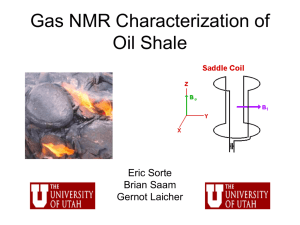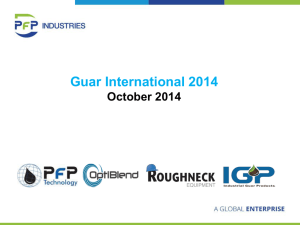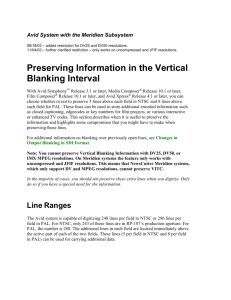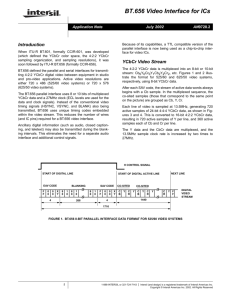Seismic Blanking in Hydrate Systems
advertisement
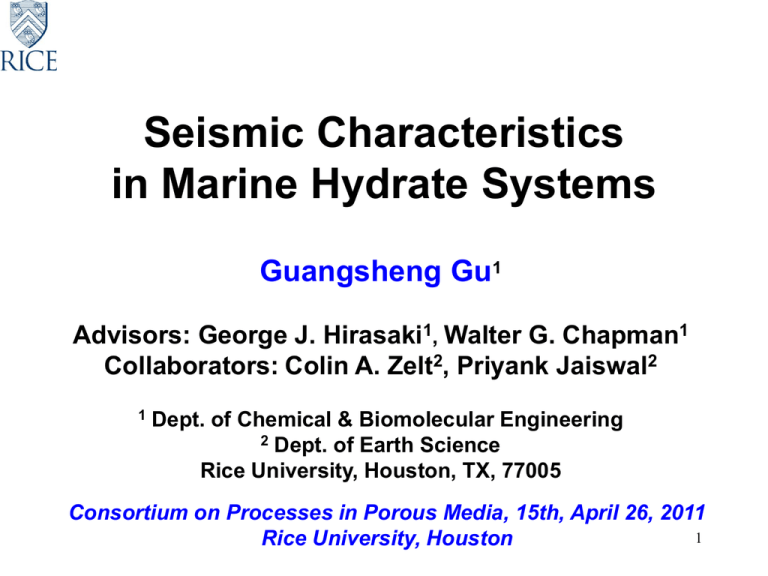
Seismic Characteristics in Marine Hydrate Systems Guangsheng Gu1 Advisors: George J. Hirasaki1, Walter G. Chapman1 Collaborators: Colin A. Zelt2, Priyank Jaiswal2 1 Dept. of Chemical & Biomolecular Engineering 2 Dept. of Earth Science Rice University, Houston, TX, 77005 Consortium on Processes in Porous Media, 15th, April 26, 2011 1 Rice University, Houston What is Gas Hydrate • Crystalline compounds, with gas molecules (e.g. CH4, C2H6) captured in water molecular cages • Dissociation: 1m3 methane hydrate = 168 m3 CH4 + 0.8 m3 H2O • Stable at high pressure and low temperature, typically in deep marine sediments or in permafrost environments 2 Why Study Hydrates? Geohazards Submarine slope failure World-wide distribution; huge potential amount, as energy resource Influence on global climate change T.S. Collett, Offshore Technol. Conf. (OTC) 2008. 3 Major Seismic Characteristics • Used to identify hydrates in marine sediments • Bottom Simulating Reflector (BSR) • Seismic Blanking in Lateral Strata • Wipeout in Gas Chimeny 4 Bottom Simulating Reflector (BSR) A strong reflector below seafloor Parallel to the seafloor Indicating the abrupt transition from hydrate to free gas phase below In good accordance with 3-phase equilibrium of a pure-methane system Hydrate or Gas Saturation Abrupt Change Taylor et al., 1992; M.W. Lee et al, 2001 5 Seismic Blanking in Lateral Strata • Hydrate accumulation induces blanking 6 Seismic Blanking MJ. Hornbach, WS. Holbrook, et al., Geophysics, v. 68, n. 1, 92–100,2003. 7 Seismic Blanking • Weak reflection in seismic profiling: R < RBSR/10 Typically R < 0.02 8 Geologic Setting In Reflection Layer 1 1, SH ,1, SW ,1, SV ,1, 1, Vp,1, Z1 Layer 2 (shale/clay) 2 , SH ,2 , SW ,2 , SV ,2 , 2 , Vp,2 , Z2 Reflection Coefficient: Z 2 Z1 R Z 2 Z1 Transmission Coefficient: 2Z 2 T Z 2 Z1 9 Estimation of Acoustic Properties Average P-wave Velocity: Revised from the Timeaverage Equation (Pearson et al., 1983). Average Density: phase i =w,H,V 10 10 Intrinsic Properties of Phases Table 1: Acoustic properties of components Component Vp (m/s) (kg/m3) Sea Water (w) 1500 1030 Hydrate (H) 3300 900 Mineral1 (sand) 200 ~ 2000 2500 Mineral2 (diatomite) 2000 2000 Reference Mineral (shale/clay) 2000 ~ 2400 2600 Acoustic velocities from W.J. Winters and W.F. Waite (2007); Sloan (2007), etc.. Nick Barton, Rock Quality, Seismic Velocity, Attenuation and anisotropy, Taylor & % Francis Group, 2007, p. 12. Table 2: Porosity and saturation ranges Parameter Value Porosity1 (in sand layer) 0.2 ~ 0.3 Porosity2 (in shale layer) 0.2~0.7 Sh 0~1 The ranges of porosity were obtained from Hirasaki (lecture note, 2006), Jenyon (2006), Magara (1980).11 11 (Case 1) Impossible to be blanking 3.4 x 10 3.3 6 Average Impedance in Sand Layer Blanking Range Shale Layer Vp 2 Average Impedance, kg/(m *s) 3.2 sand = 1000 sand = 0.3 3.1 Vp shale shale = 2400 = 0.5 3 2.9 2.8 2.7 Sand Layer 2.6 2.5 2.4 0 0.2 0.4 0.6 0.8 1 Sh, % 12 (Case 2) Possible to be blanking 3.9 x 10 6 Average Impedance in Sand Layer Vpsand = 1500 2 Average Impedance, kg/(m *s) 3.8 sand = 0.3 Vp shale = 2400 shale = 0.5 Sand Layer 3.7 3.6 3.5 Shale Layer Blanking Range 3.4 3.3 3.2 0 0.2 0.4 0.6 0.8 1 Sh, % 13 (Case 3 ) Impossible to be blanking 5 x 10 Average Impedance in Sand Layer sand = 0.3 4.8 Vpsand = 2000 4.6 shale = 0.5 Vpshale = 2400 2 Average Impedance, kg/(m *s) 6 Sand Layer 4.4 4.2 4 3.8 Blanking Range 3.6 3.4 Shale Layer 3.2 0 0.2 0.4 0.6 Sh, % 0.8 1 14 Reflection Coeffiecient Reflection Coefficient from A certain layer to Clay Layer 0.02 -0. 02 0 -0. 04 -0. 02 0 0 . -0. 06 04 -0. 02 -0. 04 -0. 06 -0. 08 -0. 06 -0. 08 -0. 1 0.65 0.6 of clay 0.55 0.5 0.45 0.4 -0. 12 -0. 1 -0. 08 -0. 14 -0. 12 -0. 1 -0. 16 -0. 14 -0. 12 -0. 18 -0. 16 -0. 14 -0. 2 -0. 18 -0. 16 -0. 22 -0. 2 -0. 18 -0. 22 -0. 2 -0. 24 0.35 0.3 0.2 0.4 -0.1 -0.15 -0.2 -0.25 -0. 24 -0. 26 0 Blanking region -0.05 -0. 22 -0. 24 -0. 26 0 Just possible to be blanking 0.6 0.8 1 Sh sand layer Sh in Layer Layer 1 (quartz) Layer 2 (Clay/Shale) porosity 0.3 0.4~0.7 Vp (m/s) 1000 2400 Density (kg/m3) 2650 2600 15 Reflection Coeffiecient 0.65 0.6 of clay 0.55 0 0.5 Reflection Coefficient from A certain 0.14 0.16 0.12 0.14 0.1 0.12 0.08 0.1 0.06 0.08 0.04 0.06 0.02 0.04 0.02 -0. 02 0.45 0.35 0.3 0.16 0.15 0.14 0.12 0.1 0.1 0.08 0.06 0.05 0.02 -0. 04 -0. 02 -0. 06 -0. 04 -0. 08 -0. 12 -0. 1 0.2 0 0 -0. 02 -0. 06 -0. 1 0 layer to Clay Layer 0.18 0.04 0 0.4 -0. 0 8 Very possible to be blanking -0.05 0 Blanking region -0. 04 -0.1 -0. 06 -0. 08 0.4 0.6 0.8 1 Sh Layer Layer 1 (quartz) Layer 2 (Clay/Shale) porosity 0.3 0.4~0.7 Vp (m/s) 1500 2400 Density (kg/m3) 2650 2600 16 Reflection Coeffiecient Reflection Coefficient from A certain layer to Clay Layer 0.24 0.3 0.26 0.22 0.28 0.2 0.24 0.65 0.22 0.26 0.18 0.2 0.6 0.18 0.16 of clay 0.55 0.14 0.1 0.16 0.12 0.5 0.4 0.35 0.3 0 0.2 0.4 0.6 0.15 0.1 0.12 0.05 0.1 0 0.08 0.04 0 0.2 0.14 0.06 0.02 -0. 0 2 0.24 0.16 0.08 0.04 0 0.25 0.2 0.1 0.06 0.02 0.18 0.12 0.08 0.04 0.22 0.14 0.1 0.45 Blanking region 0.2 Just Possible to be blanking 0.06 0.8 1 Sh Layer Layer 1 (quartz) Layer 2 (Clay/Shale) porosity 0.3 0.4~0.7 Vp (m/s) 2000 2400 Density (kg/m3) 2650 2600 17 Different Layer (Diatomite vs. Clay) Reflection Coefficient from Diatomite to Clay Layers 0.0 -0. -0. 0. 0.08 0 0 2 06 04 0. .0 06 02 4 -0. 08 14 0. 12 0. 1 0. 0.15 0.65 -0 . 0.6 -0.1 2 -0 . 14 0.55 -0 .1 -0 . -0 . 2 -0.15 1 12 14 Blanking region -0.2 04 18 -0.1 . -0 16 04 08 0.2 -0 . 0 -0.05 . -0 0 08 -0 . 06 -0 . 0.4 14 -0 . 2 -0 . 06 . -0 0.45 -0.2 -0 . 12 -0 . 02 02 0. -0 . 1 0.05 0. 02 0 0 -0 . 8 -0 . 02 0.5 04 08 -0 . 6 -0 . . -0 -0 .1 -0 . 06 0.1 08 0. 06 0. 04 0. of clay -0. 1 Very possible to be blanking -0.25 0.4 0.6 0.8 1 Sh Layer Layer 1 (Diatomite) Layer 2 (Clay/Shale) porosity 0.65 0.4~0.7 Vp (m/s) 2000 2400 Density (kg/m3) 2000 2600 18 Conclusion Hydrate accumulation in marine sediment is helpful for blanking; Sensitive to parameters and stratum lithology; Hydrate accumulation doesn’t guarantee a blanking. 19 Wipeout in gas chimney Wipe out in vertical columnar regions KIGAM data showing BSR in debris-flow deposits (DFD). BSR is weak and discontinuous. Seismic chimneys look very narrow due to vertical exaggeration (ca. 14×). Seismic chimney, marked by S, is about 820 m wide and 110 m tall above the BSR, forming a rather horizontal zone of amplitude reduction. DFD, debris-flow deposits; THS, turbidite/hemipelagic sediments. S. Horozal et al., Marine Geology 258: 126–138, 2009. 20 gas chimney Northern Cascadia margin near Ocean Drilling Program (ODP) Site 889/890. Geological Society of America Bulletin, Riedel, 2006.21 Riedel, 2006. 22 chimney S. Horozal et al., Marine Geology 258: 126–138, 2009. 23 Mechanisms • Due to gas bubbles in the GHSZ in the Cascadia Margin (Wood et al., 2002). These gas bubbles may be coated with hydrate that prevents the inflow of water (Riedel et al., 2006). • Due to a thermal (Wood et al., 2002) or a thermochemical effects (Hornbach et al., 2005) • Due to presence of gas hydrate, and intrinsic acoustic properties in sediments (Chand and Minshull, 2003.). 24 Acknowledgement • DOE Grant (No. DE-FC26-06NT42960) • Rice University, Hirasaki Group, Chapman Group • Colleagues in Earth Science Department 25

